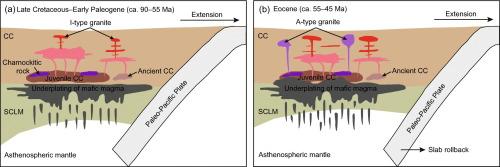Petrogenesis of the Late Cretaceous–Paleogene I- and A-type granite association from the Gyeongsang Basin, southeastern Korean Peninsula
IF 2.5
2区 地球科学
Q2 GEOCHEMISTRY & GEOPHYSICS
引用次数: 0
Abstract
Rare highly fractionated A-type granites are spatially associated with Late Cretaceous–Paleogene I-type granitoids in southeastern Korea. We present new zircon U-Pb ages and Hf isotopic compositions and whole-rock geochemical and Sr–Nd–Pb isotopic data for Late Cretaceous–Paleogene granitoids that crop out in the Gyeongsang Basin, SE Korea, to constrain their origin and the genetic relationship between the I- and A-type granites. The samples can be divided into three groups: (1) I-type low-silica granitoids (SiO2 = 61–65 wt%), (2) I-type high-silica granites (SiO2 = 71–78 wt%), and (3) A-type alkali feldspar granites (SiO2 = 77–82 wt%). SHRIMP zircon U-Pb dating yields ages of 77–52 Ma for the I-type granites and 55–53 Ma for the A-type granites. Both I- and A-type granitoids have juvenile whole-rock Sr–Nd–Pb and zircon Hf isotopic compositions that are distinct from those of the Precambrian basement in the Yeongnam Massif. The I-type granitoids were most likely produced by adding <15 % of ancient-crust-derived melts to the magma derived from juvenile Paleozoic crust. In contrast to the I-type granitoids, the A-type granites are characterized by high SiO2 and heavy rare earth element contents and large negative Ba, Sr and Eu anomalies. We propose that the A-type granites were produced by partial melting of dehydrated charnockitic rocks in the middle–lower crust. Both the I- and A-type granitoids were emplaced during crustal extension induced by rollback of the subducting paleo-Pacific plate. Starting during the Early Cretaceous, a retreating arc system led to increased extension, lithospheric thinning, and underplating of mantle-derived magmas. This caused the heat-flux melting of both juvenile and ancient basement rocks, leaving dehydrated charnockitic material above the I-type source. During the late stages of the Late Cretaceous magmatism, the charnockitized crustal rocks melted at high temperatures, leading to the formation of the A-type granites.

朝鲜半岛东南部庆尚盆地晚白垩世-古近纪I型和a型花岗岩组合的岩石成因
韩国东南部地区罕见的高分异a型花岗岩在空间上与晚白垩世—古近系i型花岗岩相关。本文对庆尚盆地晚白垩世—古近系花岗岩进行了锆石U-Pb年龄、Hf同位素组成、全岩地球化学和Sr-Nd-Pb同位素测定,以确定其成因以及I型和a型花岗岩的成因关系。样品可分为3组:(1)i型低硅花岗岩(SiO2 = 61 ~ 65 wt%), (2) i型高硅花岗岩(SiO2 = 71 ~ 78 wt%), (3) a型碱长石花岗岩(SiO2 = 77 ~ 82 wt%)。SHRIMP锆石U-Pb定年结果显示,ⅰ型花岗岩年龄为77 ~ 52 Ma, a型花岗岩年龄为55 ~ 53 Ma。I型和a型花岗岩的全岩Sr-Nd-Pb和锆石Hf同位素组成与岭南地块前寒武纪基底不同。i型花岗岩类极有可能是在古生代幼壳岩浆中加入15%的古壳源熔体形成的。与i型花岗岩相比,a型花岗岩具有SiO2含量高、稀土元素含量重、Ba、Sr、Eu负异常大的特征。我们认为a型花岗岩是由中下地壳脱水炭质岩石部分熔融形成的。I型和a型花岗岩类都是在古太平洋板块俯冲回滚引起的地壳伸展过程中形成的。从早白垩纪开始,一个撤退的弧系统导致了扩张的增加,岩石圈变薄,地幔岩浆的底部。这导致了幼年和古代基底岩石的热通量熔化,在i型源上方留下脱水的炭质物质。在晚白垩世岩浆活动晚期,炭化的地壳岩石在高温下熔化,形成了a型花岗岩。
本文章由计算机程序翻译,如有差异,请以英文原文为准。
求助全文
约1分钟内获得全文
求助全文
来源期刊

Lithos
地学-地球化学与地球物理
CiteScore
6.80
自引率
11.40%
发文量
286
审稿时长
3.5 months
期刊介绍:
Lithos publishes original research papers on the petrology, geochemistry and petrogenesis of igneous and metamorphic rocks. Papers on mineralogy/mineral physics related to petrology and petrogenetic problems are also welcomed.
 求助内容:
求助内容: 应助结果提醒方式:
应助结果提醒方式:


